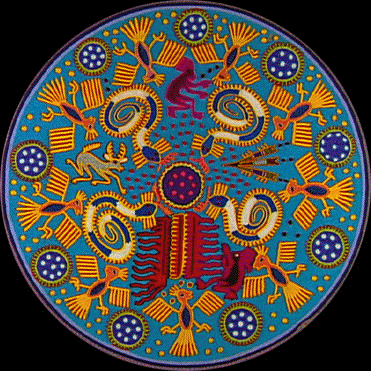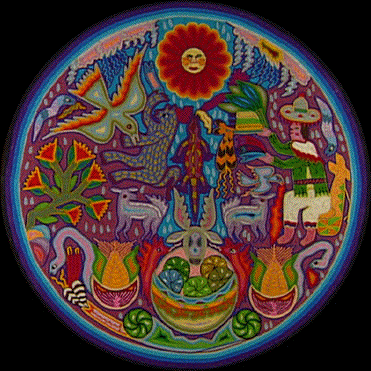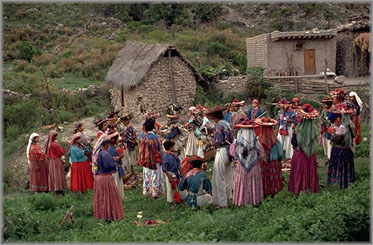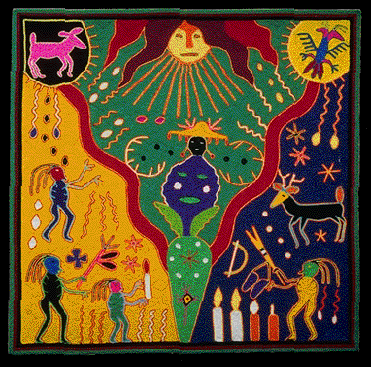The Huichol Indians |
||||||
|
|
||||||
 |
 |
The Huichol People of central Mexico still follow the age-old shamanic ways of their ancestors, an unbroken wisdom-bridge stretching back into the Paleolithic. The "mara'akame", the shaman, still leads pilgrims on a yearly journey retracing the path of the Gods and Goddesses when they first appeared in this middle world and traveled on sacred pilgrimage to find its center. The Pilgrimage culminates in a night-long ceremony
around "Tatewari", Grandfather Fire, a meditative retreat
during which shamanic ceremony induces a visionary state by which the
Huichol People find their lives and the power, the "kupuri",
to follow their heart path to completion. Their distinctive visionary
art, in the form of yarn paintings, embroided clothing, bags, beaded
gourds, masks, jewelry, and sculpture, all derives from their shamanic
visions whose symbols form the basis of their work and their lives.
The Huichol do not have a word which corresponds to
what we of the Western tradition have called hallucination. Our
definition of the word would be unthinkable for a Huichol who knows
nothing of such foolish terms concocted by a paranoid establishment and
its "paid for" psychologists. The flow of sacred imaging
through the mind's eye is always present within the individual as can be
seen by the various ways of accessing it around the world through
shamanic, religious, meditative and various forms of physical
manipulation and chemical means. The Huichol have practised this way of
seeing beyond the normal physical realm for eons and live in communal
balance long before the Europeans arrived with their chains.
The Images expressed in their artwork are always
representing stories, legends of their mythology that organize every
aspect of their world and lives. The basis of their rituals are the
songs of the Shamans (Marakame) and the main one says: "If you have
been made of corn (eekoo) and you eat the peyote (heekoori) - the cactus
that is the real core of the corn - you become the Jaguar (maye), that
hunts your deer (maxra) - that is your own spirit - and listen to the
song of the oldest and biggest deer (Tamatz Kauyumari) - who gives you
the power - and Scorpion (Terooka) and the feather sticks (Moowieri) to
heal, sing and dance".
The geometric intricacy of their art
reflects the patterns of primordial archetypes present within each of
us. Their art is a literal physical translation of imagery seen during
their expanded state of awareness, induced by their sacred cactus. This
art is a tangible manifestation of their experience in the realm of the
gods for each of us to see, touch, and commune with, becoming vehicles
for our own contemplation and transformation.
|
||||
 |
||||||
 |
||||||
| Tacutsi
Aramara, the Goddess of Life, is the Mother Goddess. From her have
sprung all life forms; humans, animals and plants. Tacutsi not only
gives life to all she nurtures, but teaches a manner of life pleasant to
the Gods. Tatewari is Grandfather Fire, instructor of shamans, giver of
light, heat, and warmth - imperative for survival. The coral and
rattlesnake are his emissaries. Wolf People. In Huichol mythology they evolved from wolves. By learning the ways of the gods, hunting the deer and offering the blood of the deer to the deities they were finally able to remain in human form. Shamans proclaim the ability to metamorphose into wolves. Fire or Tai, regarded as the most valuable gift of the gods, is honored in all Huichol ceremonies. The Huichol consider themselves sons and daughters of Tai and "feed" him cornmeal cakes, beer or tepache and water from sacred springs. Spirit Guides are intermediaries between spiritual and human spheres provided by the gods for shaman apprentices. The guide appears in dreams and visions and are often half-human, half animal, i.e., deer-man or deer-woman. Shamans or ambassadors to the gods are spiritual leaders called Marakame. They are considered para-normal in their powers and are an integral link between the Huichol and the deities. Tao Jreeku, or Father Sun, rules the heavens, bringing warmth and illumination. Eagle, Mother Goddess of all living things and the sky, is his wife. It is believed all living things receive their life force from Tao Jreeku. He is their grantor of abundant and healthy crops. All birds are messengers to the gods. The feathers of eagles, and turkeys are especially sought after. The doubled-headed eagle represents the Shaman's omnipotent power and ability to see in all directions. The goddess, Mother Eagle, Mother of the Sky and Queen of the Heavens, is embodied by the eagle or Wealika. Deer or Mahjrah in Huichol symbolize Kayumahli, the spirit guide. Kayumahli is the guide, teacher and channel of knowledge for the Shamans. The deer hunt, capture and slaying is a very ritualized ceremony. Only the "pure" may participate. For the insurance of a good crop the deer blood is offered to the Deer Mother. Tah Tay Mahjrahlee. As a guardian spirit she is one of the animals of primary importance in the shamanism of the Huichol. The unity of men and women on their spiritual journeys is symbolized by the male and female deer depicted together. Gila Monsters or Eemuukwee are believed to be endowed with magical healing powers. A piece of this reptile's tail is often seen in a Shaman's medicine basket. Teh-Kah or horned toads are trusted confederates of the shamans. Their ability to squirt blood from their eyes grants them special honors. Salamanders work the Rain Mother by prodding the clouds into letting go of the rain. Turtles also are emissaries of the Rain Goddess. Their function is to purify water and replenish underground springs. Serpents are middlemen between men and the spirit world. Rattlesnakes are respected as the tongue of Tatewari, the Fire God. The Rain Goddess is often symbolized by the Serpent as rain itself, a great coiled serpent or storm clouds from which millions of tiny snakes represent rainfall. Tortukas or scorpions are held in awe and dread. One of the most deadly species of scorpions in the world can be found in the Sierra del Nayarit. In spite of the fact that many Huichol die yearly of scorpion bites, the scorpion is respected as a protector against evil and bad luck. Pumas, mountain lions, or Mayetze are emissaries of the God of Fire, Tatewali. They are the custodians of a shaman's sacred vows. And if the shaman fails, Mayetze can consume his spirit. Wolves or Kumukite are esteemed bearers of spirits. In the peyote ceremonies Kumkite is bestowed with special honors, since the Huichol believe they descended from the Wolf People. Flowers are sacred. They are utilized in all ceremonies, healings, deer hunt, or of the new corn. Toto, a small white flower that blooms in the wet corn growing season, has become a prayer and a symbol for the corn. In life the Toto has five petals but in art it has been stylized with six petals. The toto flower symbol is often seen on the chest of the Eagle, Keli or Solandra, a plant of the Solanaceae family is an hallucinogenic. The aroma of its blossom induces a powerful trance in which the Huichol say their spirit is opened to the highest levels of enlightenment. Healing wands or arrows, Muwieris or Muvieli, have to hawk or eagle feathers suspended from the shaft. It is the Huichol belief that feathers are endowed with mysterious powers and as such the Muwieris are the most important item in a shaman's basket. With the colors on the shaft and the type of bird feather the shaman can speak to or summon individual deities. Turkeys are the bird of the sun and their feathers are sought after by peyote pilgrims. The feathers on the Muwieris are the antlers of the deer. Feathers light and fast impart their power to the shafts to which they are attached and thus insure speedy delivery of a petition or prayer to the designated deity. Tucuatsi, or a medicine basket, is woven out of palm fronds. The shaman stores his sacred magic power objects, arrows, candles, crystals, face paint, incense, mirrors, sacred plants and rocks, snake or Gila monster tails or wands in a tacuatsi. Offering mats or Eetalees are mats made especially to hold the sacred objects of the shamans medicine basket or tacuatsi during ceremonies. These objects being sacred must never touch the bare ground. Uwene or the shaman's chair are special chairs of distinctive form constructed of bamboo, oak, deerskin, pitch and fiber. The gods are supplied with a similar chair but in miniature. These uwene are utilized exclusively by male shamans. It is believed a woman would become infertile if she sat in a uwene. Each shaman transports his own uwene to the ceremony in which he is to participate. Gourd bowls depicted in yarn paintings serve to illustrate to the gods, graphically, that which is desired. Incense burners fashioned of clay are used to transport the burning coals to the necessary sacred locations. The incense or putzee is produced from the sap of the copal tree. When burned the odor and smoke of the copal transports prayers to the deities. Candles or Catilas are believed to embody the sacred gift of light from the Sun and Fire Gods. They signify an illumination of the human spirit. Caves are sacred ceremonies sites utilized by the shamans. Secreted from the outer world, with only their animal allies as witness, the shaman communicates with the mystic realm. |
||||||


